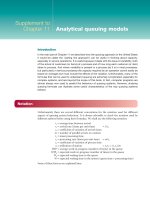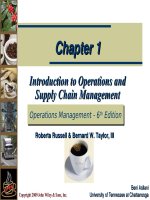Operation management 6e by russel and taylor ch14
Bạn đang xem bản rút gọn của tài liệu. Xem và tải ngay bản đầy đủ của tài liệu tại đây (2.02 MB, 40 trang )
Chapter 14
Sales and Operations Planning
Operations
Operations Management
Management -- 66thth Edition
Edition
Roberta Russell & Bernard W. Taylor, III
Copyright 2009 John Wiley & Sons, Inc.
Beni Asllani
University of Tennessee at Chattanooga
Lecture Outline
The Sales and Operations Planning
Process
Strategies for Adjusting Capacity
Strategies for Managing Demand
Quantitative Techniques for Aggregate
Planning
Hierarchical Nature of Planning
Aggregate Planning for Services
Copyright 2009 John Wiley & Sons, Inc.
14-2
Sales and Operations Planning
Determines the resource capacity needed to
meet demand over an intermediate time
horizon
Aggregate refers to sales and operations planning
for product lines or families
Sales and Operations planning (S&OP) matches
supply and demand
Objectives
Establish a company wide game plan for allocating
resources
Develop an economic strategy for meeting
demand
Copyright 2009 John Wiley & Sons, Inc.
14-3
Sales and Operations Planning
Process
Copyright 2009 John Wiley & Sons, Inc.
14-4
The Monthly S&OP Planning
Process
Copyright 2009 John Wiley & Sons, Inc.
14-5
Meeting Demand Strategies
Adjusting capacity
Resources necessary to meet demand
are acquired and maintained over the
time horizon of the plan
Minor variations in demand are handled
with overtime or under-time
Managing demand
Proactive demand management
Copyright 2009 John Wiley & Sons, Inc.
14-6
Strategies for Adjusting Capacity
Level production
Producing at a constant rate
and using inventory to
absorb fluctuations in
demand
Overtime and under-time
Subcontracting
Chase demand
Hiring and firing workers to
match demand
Maintaining resources for
high-demand levels
Let outside companies
complete the work
Part-time workers
Peak demand
Increasing or decreasing
working hours
Hiring part time workers to
complete the work
Backordering
Copyright 2009 John Wiley & Sons, Inc.
Providing the service or
product at a later time period
14-7
Level Production
Demand
Units
Production
Time
Copyright 2009 John Wiley & Sons, Inc.
14-8
Chase Demand
Demand
Units
Production
Time
Copyright 2009 John Wiley & Sons, Inc.
14-9
Strategies for Managing Demand
Shifting demand into
other time periods
Incentives
Sales promotions
Advertising campaigns
Offering products or
services with countercyclical demand patterns
Partnering with suppliers
to reduce information
distortion along the
supply chain
Copyright 2009 John Wiley & Sons, Inc.
14-10
Quantitative Techniques For AP
Pure Strategies
Mixed Strategies
Linear Programming
Transportation Method
Other Quantitative
Techniques
Copyright 2009 John Wiley & Sons, Inc.
14-11
Pure Strategies
Example:
QUARTER
SALES FORECAST (LB)
Spring
Summer
Fall
Winter
80,000
50,000
120,000
150,000
Hiring cost = $100 per worker
Firing cost = $500 per worker
Inventory carrying cost = $0.50 pound per quarter
Regular production cost per pound = $2.00
Production per employee = 1,000 pounds per quarter
Beginning work force
= 100 workers
Copyright 2009 John Wiley & Sons, Inc.
14-12
Level Production Strategy
Level production
(50,000 + 120,000 + 150,000 + 80,000)
= 100,000 pounds
4
QUARTER
Spring
Summer
Fall
Winter
SALES
FORECAST
80,000
50,000
120,000
150,000
PRODUCTION
PLAN
INVENTORY
100,000
100,000
100,000
100,000
400,000
20,000
70,000
50,000
0
140,000
Cost of Level Production Strategy
(400,000 X $2.00) + (140,00 X $.50) = $870,000
Copyright 2009 John Wiley & Sons, Inc.
14-13
Chase Demand Strategy
QUARTER
SALES
PRODUCTION WORKERS WORKERS WORKERS
FORECAST PLAN
NEEDED
HIRED
FIRED
Spring
Summer
80,000
50,000
80,000
50,000
80
50
0
0
20
30
Fall
Winter
120,000
150,000
120,000
150,000
120
150
70
30
0
0
100
50
Cost of Chase Demand Strategy
(400,000 X $2.00) + (100 x $100) + (50 x $500) = $835,000
Copyright 2009 John Wiley & Sons, Inc.
14-14
Level Production with Excel
Copyright 2009 John Wiley & Sons, Inc.
14-15
Chase Demand with Excel
Copyright 2009 John Wiley & Sons, Inc.
14-16
Mixed Strategy
Combination of Level Production and
Chase Demand strategies
Examples of management policies
no more than x% of the workforce can be
laid off in one quarter
inventory levels cannot exceed x dollars
Many industries may simply shut down
manufacturing during the low demand
season and schedule employee
vacations during that time
Copyright 2009 John Wiley & Sons, Inc.
14-17
Mixed Strategies with Excel
Copyright 2009 John Wiley & Sons, Inc.
14-18
Mixed Strategies with Excel
(cont.)
Copyright 2009 John Wiley & Sons, Inc.
14-19
General Linear Programming (LP)
Model
LP gives an optimal solution, but demand
and costs must be linear
Let
Wt = workforce size for period t
Pt =units produced in period t
It =units in inventory at the end of period t
Ft =number of workers fired for period t
Ht = number of workers hired for period t
Copyright 2009 John Wiley & Sons, Inc.
14-20
LP MODEL
Minimize Z = $100 (H1 + H2 + H3 + H4)
+ $500 (F1 + F2 + F3 + F4)
+ $0.50 (I1 + I2 + I3 + I4)
+ $2 (P1 + P2 + P3 + P4)
Subject to
P1 - I 1
= 80,000
I1 + P2 - I2
= 50,000
I2 + P3 - I3
= 120,000
I3 + P4 - I4
= 150,000
(4)
Production
1000 W1
= P1
(5)
constraints
1000 W2
= P2
(6)
1000 W3
= P3
(7)
1000 W4
=P
14-21 4
(8)
(1)
Demand
(2)
constraints
(3)
Copyright 2009 John Wiley & Sons, Inc.
Setting up the Spreadsheet
Copyright 2009 John Wiley & Sons, Inc.
14-22
The LP Solution
Copyright 2009 John Wiley & Sons, Inc.
14-23
Transportation Method
SUBCONTRACT
QUARTER
1
CAPACITY
500
2
500
3
500
4
500
EXPECTED
REGULAR
OVERTIME
DEMAND
CAPACITY
CAPACITY
1500
1200
150
1600
1300
200
3000
1300
200
900
1000
Regular production cost per unit
Overtime production cost per unit
Subcontracting cost per unit
Copyright 2009 John Wiley & Sons, Inc.
100
$20
$25
$28
14-24
Transportation Tableau
PERIOD OF USE
PERIOD OF PRODUCTION
1
Beginning
Inventory
1 Regular
2
0
3
300
600
Overtime
Subcontract
2 Regular
3
6
—
20
300
100
—
26
—
28
31
28
31
34
37
20
23
26
Overtime
Subcontract
—
25
28
28
31
3 Regular
1300
Overtime
200
Subcontract
4 Regular
20
25
28
100
—
150
250
—
—
500
1300
Overtime
200
Subcontract
500
Demand
900
300
29
25
1200
1500
Copyright 2009 John Wiley & Sons, Inc.
1600
Capacity
9
—
23
Unused
Capacity
4
3000
1000
34
100
500
1200
31
34
150
250
23
500
1300
28
200
31
500
20
1300
25
200
28
500
250
14-25









